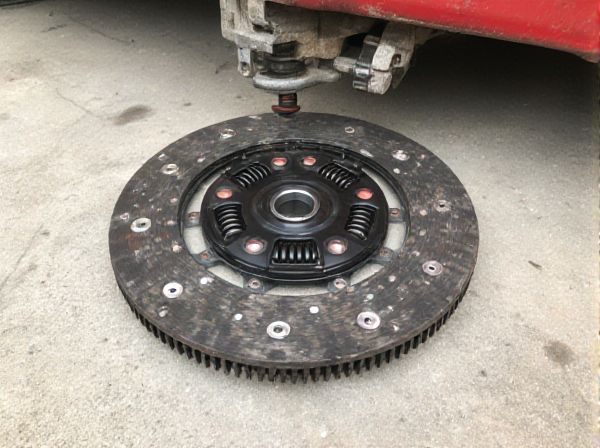
Photo illustration: Unsprung Clutch vs Sprung Clutch
A sprung clutch features springs that absorb shocks and reduce vibrations, providing smoother engagement and longer component life. An unsprung clutch lacks these springs, resulting in a more direct power transfer but increased wear and harsher operation. Choosing between the two depends on your vehicle's performance needs and driving style.
Table of Comparison
| Feature | Unsprung Clutch | Sprung Clutch |
|---|---|---|
| Shock Absorption | Minimal; direct engagement | High; absorbs vibrations and shocks |
| Durability | Less; higher wear due to impact stress | More durable via reduced stress |
| Smoothness | Rough engagement and disengagement | Smoother clutch operation |
| Performance | Better for racing; quick response | Better for street driving; comfort focus |
| Cost | Lower manufacturing cost | Higher cost due to added components |
| Application | Motorsport, performance cars | Daily use, regular vehicles |
Introduction to Clutch Systems
Clutch systems play a crucial role in vehicle drivetrains by engaging and disengaging power transmission between the engine and wheels. Unsprung clutches lack a spring mechanism, resulting in direct, immediate power transfer ideal for performance vehicles seeking precise control and minimal slippage. Sprung clutches incorporate springs that absorb shock and provide smoother engagement, enhancing drivability and reducing wear in everyday driving conditions.
What is an Unsprung Clutch?
An unsprung clutch is a type of clutch system where the clutch plates are directly connected without any springs to absorb shocks or vibrations, resulting in more immediate power transfer and responsiveness. This design reduces rotational inertia, enhancing acceleration and engine response but may cause increased wear and harsher engagement due to lack of damping. Commonly used in racing and high-performance motorcycles, unsprung clutches prioritize efficiency and direct feedback over smoothness.
What is a Sprung Clutch?
A sprung clutch features internal coil springs that absorb torque fluctuations and provide smoother engagement between the engine and transmission. This design reduces driveline shock and vibrations, enhancing ride comfort and protecting drivetrain components from sudden stress. Commonly used in motorcycles and passenger vehicles, sprung clutches improve overall control and durability by damping shock loads during gear changes.
Key Differences Between Unsprung and Sprung Clutches
Unsprung clutches use a direct connection with minimal cushioning, providing quicker engagement and improved power transfer, ideal for high-performance motorcycles. Sprung clutches incorporate springs or dampers that absorb shock and reduce drivetrain noise, resulting in smoother operation and increased durability. The key difference lies in the balance between responsiveness and comfort, with unsprung clutches favoring performance and sprung clutches prioritizing longevity and rider comfort.
Performance and Responsiveness Comparison
Unsprung clutches offer superior performance and responsiveness due to their direct engagement, minimizing rotational mass and enhancing power transfer efficiency in high-performance vehicles. Sprung clutches incorporate springs that absorb shock and vibrations, resulting in smoother but slightly delayed engagement, making them ideal for everyday driving conditions. The reduced inertia of unsprung clutches enables quicker throttle response and faster gear shifts, while sprung clutches prioritize driver comfort and longevity over aggressive performance.
Comfort and Driveability: Which Clutch is Smoother?
Unsprung clutches offer a more direct connection between the engine and transmission, resulting in quicker power transfer but often at the expense of comfort due to increased vibrations felt through the drivetrain. Sprung clutches incorporate a series of springs within the clutch disc that absorb shocks and vibrations during engagement, providing a smoother and more comfortable driving experience. For drivers prioritizing driveability and reduced cabin noise, sprung clutches typically deliver superior comfort and seamless gear transitions compared to the more rigid unsprung counterparts.
Durability and Maintenance Considerations
Unsprung clutches typically offer greater durability due to fewer moving parts and a simpler design, resulting in less wear and tear over time compared to sprung clutches. Maintenance is generally easier and less frequent for unsprung clutches, as there are no springs to replace or adjust, reducing overall service costs. Sprung clutches require regular inspection and spring tension adjustments to maintain optimal performance, which can increase maintenance efforts and potentially shorten component lifespan.
Best Applications for Unsprung Clutches
Unsprung clutches, characterized by the absence of springs, offer direct and immediate power transfer, making them ideal for high-performance motorcycles and racing applications where rapid throttle response and minimal slippage are crucial. They excel in environments requiring durability under high torque and frequent load changes, such as off-road or motocross racing. The rigid engagement of unsprung clutches enhances traction control and reduces energy loss, optimizing acceleration and overall engine responsiveness.
Ideal Uses for Sprung Clutches
Sprung clutches are ideal for applications requiring smoother engagement and reduced shock load on the drivetrain, such as in street vehicles and daily drivers. Their internal springs absorb torque fluctuations, enhancing comfort and drivability by minimizing jerk during gear shifts. This makes sprung clutches particularly suitable for stop-and-go traffic conditions and high-torque engines where longevity and smooth operation are prioritized.
Choosing the Right Clutch for Your Needs
Choosing the right clutch depends on your vehicle's performance requirements and driving style. An unsprung clutch offers more direct power transfer and quicker engagement, making it ideal for racing or high-performance applications, whereas a sprung clutch provides smoother operation and better shock absorption, suitable for daily driving and longevity. Understanding the difference in these clutches' construction and behavior helps optimize efficiency, durability, and overall driving experience.
 caratoz.com
caratoz.com